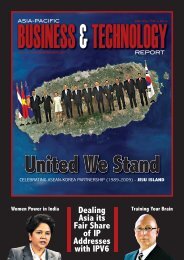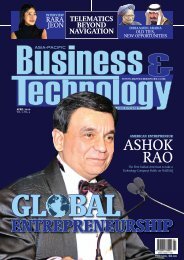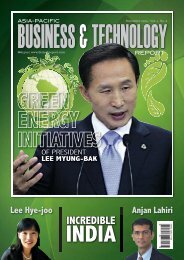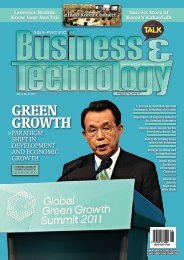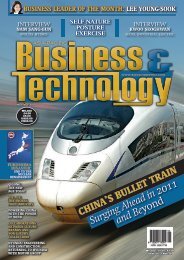INDIA-KOREA - Asia-Pacific Business and Technology Report
INDIA-KOREA - Asia-Pacific Business and Technology Report
INDIA-KOREA - Asia-Pacific Business and Technology Report
Create successful ePaper yourself
Turn your PDF publications into a flip-book with our unique Google optimized e-Paper software.
<strong>INDIA</strong>-<strong>KOREA</strong><br />
Glorious Past Bright Future<br />
Continued from Page 24<br />
dai are well-established br<strong>and</strong> names in India,<br />
the Prime Minister proposed that the<br />
future is for small <strong>and</strong> middle-sized Korean<br />
companies to establish their manufacturing<br />
units in India <strong>and</strong> break into the enormous<br />
opportunities, the Indian markets<br />
offer.<br />
India <strong>and</strong> Korea have also taken a fresh<br />
look at the Science <strong>and</strong> <strong>Technology</strong> sector<br />
<strong>and</strong> have proposed the establishment<br />
of the Joint Science <strong>and</strong> <strong>Technology</strong> Fund<br />
of US$10 million, to encourage greater interaction<br />
of the scientific community between<br />
the two nations.<br />
FDI <strong>and</strong> India<br />
The present Foreign Direct Investment in<br />
India has become the focus of several trade<br />
bodies as they watch the issues related to<br />
one of the largest FDI deals in India, the<br />
POSCO Steel Project, worth US$12 billion.<br />
As local people object to the establishment<br />
of the steel industry near their community,<br />
the st<strong>and</strong> of the Indian government<br />
<strong>and</strong> the related issues of implementation<br />
were addressed by the Prime Minister during<br />
his several interactions with the South<br />
Korean business community. Assuring that<br />
the scenario was soon to become profitable<br />
for foreign investment, he encouraged the<br />
community to invest in India.<br />
Showcasing India’s readiness for further<br />
business ventures, the Prime Minister<br />
said that, “India has maintained an annual<br />
growth of 7 percent in the last several years<br />
<strong>and</strong> it will increase in the coming years; India<br />
also has a domestic saving rate of 33-35<br />
percent of GDP.<br />
He also highlighted that, “We have a<br />
very favorable demographic factor with<br />
half the working population in their twenties;<br />
India has heavily invested in education,<br />
health <strong>and</strong> agriculture. The middle<br />
class is growing in size <strong>and</strong> importance.<br />
Further, rural markets are also exp<strong>and</strong>ing<br />
markedly.”<br />
Speaking further on the Indian markets,<br />
he said that, “India has plans to invest<br />
about one trillion US dollars in the next five<br />
years in developing infrastructure projects<br />
like airports, highways, ports, power plants<br />
<strong>and</strong> modern transport systems. India’s energy<br />
security policies that include energy<br />
efficiency <strong>and</strong> renewables will provide new<br />
opportunities to Korea’s environmentally<br />
friendly technologies.”<br />
The Economic Road Map of<br />
India <strong>and</strong> South Korea<br />
The strong historic <strong>and</strong> cultural ties<br />
forged over the centuries has led to mutual<br />
trust <strong>and</strong> underst<strong>and</strong>ing. The current need<br />
for both countries is to take the existing<br />
levels of trade to a higher level, allowing for<br />
greater exchange of science, technology,<br />
<strong>and</strong> electronics expertise in India while at<br />
the same time opening South Korean markets<br />
for Information <strong>Technology</strong> services<br />
<strong>and</strong> related opportunities of Indian expertise.<br />
Education <strong>and</strong> strategic relations, such<br />
as the launching of South Korean satellites,<br />
will increase the volumes of trade in space<br />
technologies.<br />
As India <strong>and</strong> South Korea enter their<br />
40th year of establishment of diplomatic<br />
ties, their governments are looking at enhancing<br />
the overall relationship both the<br />
countries share. A-P<br />
India Forges Better Ties<br />
With East <strong>Asia</strong><br />
by Rashmi Gupta<br />
With recent<br />
sweeping changes<br />
in the world<br />
order, the role of India has<br />
increasingly come under<br />
the arch lights.<br />
While one view point is that India will<br />
continue to play a regional role as the United<br />
States <strong>and</strong> China grapple for the centre<br />
of global power, there are also views that<br />
India could well emerge under from under<br />
the dragon’s <strong>and</strong> eagle’s shadows to create<br />
another new world order.<br />
One of the significant strategies that today<br />
might allow India to become a super<br />
power includes a fundamental shift that<br />
took place in the mid-nineties when India<br />
paused its ‘Look-US’ policies <strong>and</strong> instead<br />
turned east. The fledging relationships of<br />
a decade ago have now matured to ensure<br />
India is at a strategic ‘pole vault’ position<br />
that will help in establishing itself within<br />
the older regional structures <strong>and</strong> help in<br />
forging new balances as well.<br />
29<br />
www.biztechreport.com<br />
Defense & STRATEGY<br />
© pib.nic.in<br />
The Prime Minister, Dr. Manmohan Singh <strong>and</strong> Smt. Gursharan Kaur in a group photograph with the East <strong>Asia</strong> Summit Heads of States <strong>and</strong><br />
their spouses, in a Gala Dinner hosted by the President of Republic of Indonesia, Dr. H. Susilo Bambang Yudhoyono, on the sidelines of the 9th<br />
ASEAN-India Summit <strong>and</strong> the 6th East <strong>Asia</strong> Summit, in Bali, Indonesia on November 18, 2011<br />
India’s Historical Ties<br />
India’s ties with East <strong>Asia</strong>n countries<br />
have largely been dictated by its relationship<br />
with China. Traditionally, <strong>and</strong> especially<br />
after the Sino-Indian in 1962, India<br />
<strong>and</strong> China had been competing neighbors.<br />
When China moved from an expansionist<br />
mode to a more competitive economic<br />
superpower mode, India was slow on the<br />
catch-up. China’s greater geographic vastness<br />
has also contributed to its greater presence<br />
in most regional economic forums<br />
<strong>and</strong> blocs across the <strong>Asia</strong>-<strong>Pacific</strong>.<br />
India’s catching-up phase with China began<br />
during the early 1990’s when the then<br />
Prime Minister Narasimha Rao (1991-96)<br />
endorsed what soon came to be known as<br />
the ‘Look East Policy’.<br />
Fortunately, his successors Shri. Atal<br />
Bihari Vajpayee (1998-2004) <strong>and</strong> Shri.<br />
Manmohan Singh, have continued to contribute<br />
towards building stronger <strong>and</strong> economic<br />
growth by encouraging policies with<br />
Easter countries.<br />
Burmese Overture Begins Look<br />
East Policy<br />
Perhaps the most significant change that<br />
showed that India was adopting a more<br />
pragmatic approach to finally don the role,<br />
soon to be thrust upon her as a future super<br />
power, was the softening of its st<strong>and</strong><br />
against the Burmese junta, with its pronon-alignment<br />
<strong>and</strong> deep support to apartheid<br />
movement. India in the late 1980s<br />
had continued to oppose Burmese militia<br />
domination of the country. However, with<br />
a strategic shift in its policies, India now<br />
plays key roles in economic <strong>and</strong> commercial<br />
activities in Burma through its state<br />
oil <strong>and</strong> industrial corporations, along with<br />
training Burmese personnel in controlling<br />
the drug cartels breaking into India’s North<br />
East frontier-states.<br />
India Bonds with East<br />
<strong>Asia</strong>n Isl<strong>and</strong>s<br />
Soon India moved to capturing commercial,<br />
economic as well as military bases in<br />
Singapore, the Philippines, Cambodia as<br />
well as Vietnam. India quickly reconciled<br />
its on-going relations with Sri Lanka with<br />
Free Trade Agreements <strong>and</strong> improved its<br />
military relations with Thail<strong>and</strong> as well.<br />
While the bulk of India’s relationships<br />
with East <strong>Asia</strong>n neighbors has been based<br />
on trade associations, it has also built a<br />
strong platform for itself as a pro-democratic<br />
nation <strong>and</strong> has supported <strong>and</strong> stood by<br />
countries which have emphasized human<br />
rights as well as democratic values. India is<br />
one of the signatories to ASEAN’s Treaty of<br />
Amity <strong>and</strong> Co-operation in Southeast <strong>Asia</strong><br />
in 2003.<br />
India Trade <strong>and</strong> Economic<br />
Treaties is the Fulcrum of its<br />
Relations with Regional States<br />
India has constructed strong free trade<br />
agreements <strong>and</strong> preferential trade agreements<br />
with most of its neighboring regional<br />
states. It has also sought an active role in<br />
the association of Southeast <strong>Asia</strong>n Nations,<br />
Continued on Page 34



